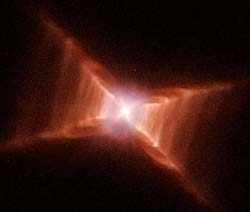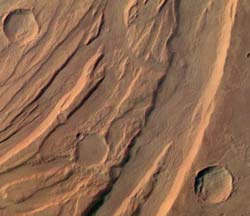This area deals with the fundamental laws and building blocks of nature and how they interact, the properties and the behavior of matter, and research into space and time and their structures.
innovations-report provides in-depth reports and articles on subjects such as astrophysics, laser technologies, nuclear, quantum, particle and solid-state physics, nanotechnologies, planetary research and findings (Mars, Venus) and developments related to the Hubble Telescope.

Astronomers may not have observed the fabled “Stairway to Heaven”, but they have photographed something almost as intriguing: ladder-like structures surrounding a dying star.
This image, taken with the NASA/ESA Hubble Space Telescope, reveals startling new details of one of the most unusual nebulae known in our Galaxy. Catalogued as HD 44179, this nebula is more commonly called the “Red Rectangle” because of its unique shape and colour as seen with ground-based telescopes.
H

Long-exposure images of the giant elliptical galaxy M87 by NASA’s Chandra X-ray Observatory, together with radio observations, have provided spectacular evidence of repetitive outbursts from the vicinity of the galaxy’s supermassive black hole. Magnetized rings, bubbles, plumes and jets ranging in size from a few thousand to a few hundred thousand light years point to ongoing violent activity for hundreds of millions of years.
“The hot X-ray emitting gas extending for hundreds of

For years, astronomers have wondered whether stars similar to the Sun go through periodic cycles of enhanced X-ray activity, like those often causing troubles to telephone and power lines here on Earth.
ESA’s X-ray observatory XMM-Newton has now revealed for the first time a cyclic behaviour in the X-ray radiation emitted by a star similar to the Sun. This discovery may help scientists to understand how stars affect the development of life on their planets.
Since the time Galil

These images were taken by the High Resolution Stereo Camera (HRSC) on board ESA’s Mars Express of the Acheron Fossae region, an area of intensive tectonic (continental ‘plate’) activity in the past.
The images show traces of enormous stress and corresponding strain in the crust of the Red Planet. The HRSC was pointed twice at this interesting geological feature in the Acheron Fossae mountain range, during orbits 37 and 143.
The feature is situated at approximately 35º-40º North a

VLT Measures Properties of New Jupiter-Size Objects in Very Close Orbits
Discovering other Worlds
During the past decade, astronomers have learned that our Solar System is not unique, as more than 120 giant planets orbiting other stars were discovered by radial-velocity surveys (cf. ESO PR 13/00, ESO PR 07/01, and ESO PR 03/03).
However, the radial-velocity technique is not the only tool for the detection of exoplanets. When a planet happens to pass in front o

Dutch researcher Steve van Straaten set a record during his doctoral research. The researcher registered the fastest ever change in the X-ray emission originating from a binary star. The record-breaking binary star consists of a neutron star and a lighter companion star.
Astronomer Steve van Straaten studied the time variations in the X-ray emission from various binary stars. He found that one of the binary stars had a vibrational frequency of 1330 Hz. This means that the intensity of the X-